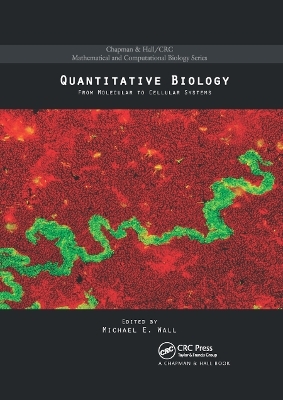
Quantitative Biology
From Molecular to Cellular Systems
Seiten
2020
CRC Press (Verlag)
978-0-367-86477-4 (ISBN)
CRC Press (Verlag)
978-0-367-86477-4 (ISBN)
Providing an overview of quantitative biology, this book presents practical tools for the observation, modeling, design, and manipulation of biological systems from the molecular to cellular levels. The book offers an introduction to fundamental concepts and computational, mathematical, and experimental studies of molecular and cellular behavior
Quantitative methods are revolutionizing modern molecular and cellular biology. Groundbreaking technical advances are fueling the rapid expansion in our ability to observe, as seen in multidisciplinary studies that integrate theory, computation, experimental assays, and the control of microenvironments. Integrating new experimental and theoretical methods, Quantitative Biology: From Molecular to Cellular Systems gives both new and established researchers a solid foundation for starting work in this field.
The book is organized into three sections:
Fundamental Concepts
covers bold ideas that inspire novel approaches in modern quantitative biology. It offers perspectives on evolutionary dynamics, system design principles, chance and memory, and information processing in biology. Methods describes recently developed or improved techniques that are transforming biological research. It covers experimental methods for studying single-molecule biochemistry, small-angle scattering from biomolecules, subcellular localization of proteins, and single-cell behavior. It also describes theoretical methods for synthetic biology and modeling random variations among cells.
Molecular and Cellular Systems focuses on specific biological systems where modern quantitative biology methods are making an impact. It incorporates case studies of biological systems for which new concepts or methods are increasing our understanding. Examples include protein kinase at the molecular level, the genetic switch of phage lambda at the regulatory system level, and Escherichia coli chemotaxis at the cellular level.
In short, Quantitative Biology presents practical tools for the observation, modeling, design, and manipulation of biological systems from the molecular to the cellular levels.
Quantitative methods are revolutionizing modern molecular and cellular biology. Groundbreaking technical advances are fueling the rapid expansion in our ability to observe, as seen in multidisciplinary studies that integrate theory, computation, experimental assays, and the control of microenvironments. Integrating new experimental and theoretical methods, Quantitative Biology: From Molecular to Cellular Systems gives both new and established researchers a solid foundation for starting work in this field.
The book is organized into three sections:
Fundamental Concepts
covers bold ideas that inspire novel approaches in modern quantitative biology. It offers perspectives on evolutionary dynamics, system design principles, chance and memory, and information processing in biology. Methods describes recently developed or improved techniques that are transforming biological research. It covers experimental methods for studying single-molecule biochemistry, small-angle scattering from biomolecules, subcellular localization of proteins, and single-cell behavior. It also describes theoretical methods for synthetic biology and modeling random variations among cells.
Molecular and Cellular Systems focuses on specific biological systems where modern quantitative biology methods are making an impact. It incorporates case studies of biological systems for which new concepts or methods are increasing our understanding. Examples include protein kinase at the molecular level, the genetic switch of phage lambda at the regulatory system level, and Escherichia coli chemotaxis at the cellular level.
In short, Quantitative Biology presents practical tools for the observation, modeling, design, and manipulation of biological systems from the molecular to the cellular levels.
Michael E. Wall is with the Computer, Computational, and Statistical Sciences Division of the Los Alamos National Laboratory in New Mexico.
Free Energies, Landscapes, and Fitness in Evolution Dynamics. System Design Principles. Chance and Memory. Information Theory and Adaptation. Quantitative In Vitro Biochemistry, One Molecule at a Time. Small-Angle Scattering. Subcellular Signaling Dynamics. Single-Cell Behavior. Modeling Genetic Parts for Synthetic Biology. Modeling Cellular Variability. PKA: Prototype for Dynamic Signaling in Time and Space. Stochastic Simulation of the Phage Lambda Gene Regulatory Circuitry. Chemotaxis.
| Erscheinungsdatum | 01.10.2020 |
|---|---|
| Reihe/Serie | Chapman & Hall/CRC Mathematical Biology Series |
| Verlagsort | London |
| Sprache | englisch |
| Maße | 174 x 246 mm |
| Gewicht | 453 g |
| Themenwelt | Naturwissenschaften ► Biologie ► Genetik / Molekularbiologie |
| Naturwissenschaften ► Physik / Astronomie ► Angewandte Physik | |
| ISBN-10 | 0-367-86477-0 / 0367864770 |
| ISBN-13 | 978-0-367-86477-4 / 9780367864774 |
| Zustand | Neuware |
| Haben Sie eine Frage zum Produkt? |
Mehr entdecken
aus dem Bereich
aus dem Bereich
50 Meilensteine der Genetik
Buch | Hardcover (2022)
Librero b.v. (Verlag)
CHF 13,90


